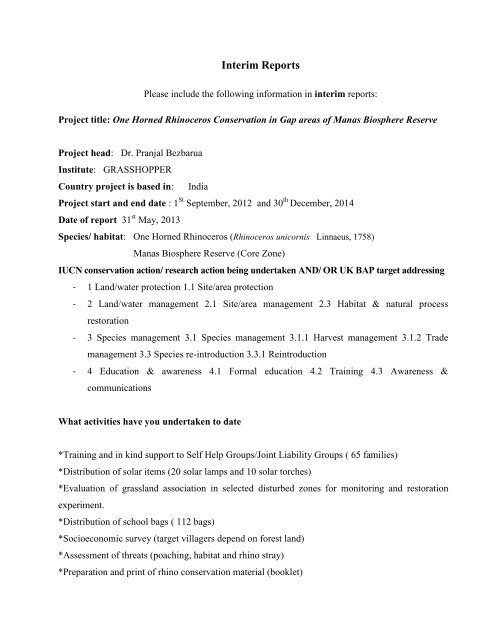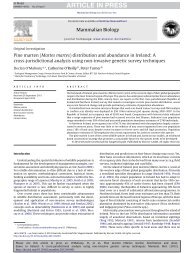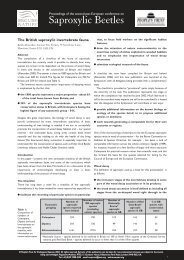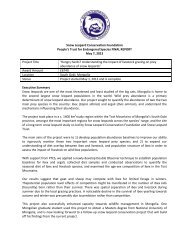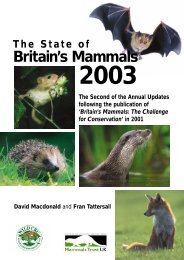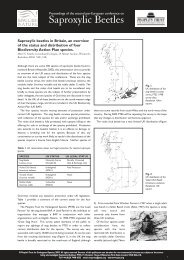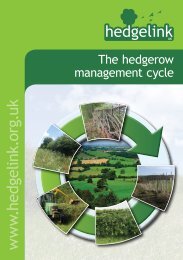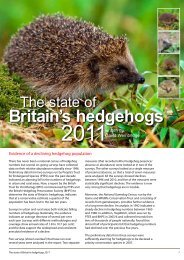progress report
progress report
progress report
Create successful ePaper yourself
Turn your PDF publications into a flip-book with our unique Google optimized e-Paper software.
threat map identifying sensitive areas inside the reserve and fringe villages. While we are focusingon community conservation related activities in some of those areas, park authority has intensifiedpetrolling and other necessary steps to minimize the threat. The solar items were favoured by foreststaff in the field and top forest official appriciated us and interested to introduce it in other ranges.Promotion of school education of poor students has encouraged parents to continue education oftheir children and secondly increase responsibility of the society in remote areas to focus in thisneglected sector. This is the part of our stretegies to build confidence amongst forest dependents ina senstive gap area to continue rhino conservation work.The socioeconomic survey in fringes of encroached area covered about 200 families while thenumber will be double or more if considered villagers affected by flood. Due to limited fund andspecific target based PTES continuation project activities, we discussed with the Planning andDevelopment department, of Government of Assam regarding more support. We were suggested togo for as per the government scheme guideline on rural development and support might be arrangedapart from 300 families. Therefore, we are arranging training for 100 families on piggery in nextphase where officials from rural department will be introduced with other potential groups/villagersand gap areas to expand rural development schemes. The socioeconomic survey also influenced inbringing awareness on benefit of conservation that linked with active participation in alternativelivelihood options amongst villagers of sensitive areas. The awareness cum motivation meetingsand following official procedure to get support of rural development departments also built capacityof our partner NGO and their staffs, community leaders, block development officials, schoolteachers and students and volunteers. Now, some of them directly contacted the rural developmentdepartment for more support. Our model work on alternative livelihood generation and awarenessthus resulted in less use of land and gradual decrease of forest dependency to favour rhino habitatrestoration and strengthen antipoaching intellegence network and replication.The most important achievement of the project is that all the self help groups continue their work;income generated for each family and money saving tendency in bank. To date, we were informedthat each family of first 10 groups can save about Rs.1000 per month. We hope to arrange for agovernment subsidy and soft bank loan for the benificiaries to build more infrastructures so that theincome increased to five times more. The official procedure was almost completed and rural
development department requested us to contact concerned bank to send the necessary documentsfrom their side for early release of the subsidy.Our partner NGO are working with villagers and a good portion of encroached land was recoveredand forest department already laid bounday pillars (seems to be recovering the whole land). But weas well as our collegue are closely monitoring the situation considering the overall sensitivepolitical situation. We believe a gradual recovery about 40-50% (as mentioned in the proposal) isgood at present and be allowed for natural restoration with low cost experimental managementintervention. This will be supported by our GIS map on waterbodies and design of the drainagesystem. Identification of waterbodies is also related to increase wallowing site inside the reserve. Sofar mix of natural grass species including rice varieties and weeds grow on the recovered land andvegetation is influenced by grazing and waterlogged condition. We are also trying for more supporton alternative livlihood from rural development department to cover all the families (more than 200families) depend on the encroached land and after that favour releasing the whole land bythemselves. The stretegy will minimize the chance of conflict between villagers and forestdepartment plus local NGOs.A better community participation in Manas can be related regarding protection ofintroduced/translocated rhino population from Kaziranga NP and Pabitora WLS that already gavebirth to 4 calfs despite poaching threat. So far four adult rhinos were poached. While the recentpoaching in Manas resulted all the stakeholders to rethink about their strategies, yet it is evident thatwith limited facilities and support from community based NGOs and volunteers, the forest authorityof Manas is successful in providing better protection to one horned rhino population in comparisonto well equipped Kaziranga national park that lost 26 rhinos till now in 2013.We hope to print the rhino conservation book in this season and will be the only material availablein local language for Manas and other rhino bearing habitats to increase awareness amongst allstakeholders and common mass.
Have you started disseminating any results – e.g. giving talks, preparing papers, producingmanagement guidelines, submitting evidence to change government policy, getting mediainterest?The information related to threat was shared with only selected top officials to take necessary stepsat field level. The preliminary assessment of the socioeconomic status and performance of the selfhelp groups including our local partners have been monitored by the rural development agencies.This resulted agencies to offer another advanced training for selected trained weavers at Kolkatacity, outside Assam. The rural development department informed us that more opportunity would begiven for other weavers for such advanced training at Guwahati and Kolkata. The official fromPlanning and Development department suggested us to act as per the guidelines of ruraldevelopment schemes to work with local community and they would provide more support to fringeareas of Manas. Our community works in Manas helped to raise sufficient support for thecommunity of Kaziranga national park, where continuous poaching is going on. The Planning andDevelopment department sanctioned good amount of money to the rural development departmentwho are helping us at Kaziranga and Manas (confidential). Regarding disemination of information,we carefully shared our community works and photographs in social network site that reach to ourconservation circle and friends. Considering the sensitiveness of the area we always keep lowprofile about our activities and give more time to self help groups and parners to continue theirwork to build a permanent model for future replication. I am planning to attend the INTECOL 2013at Excel London in August, 2013 and deliver a talk on grassland dynamics and communityconservation action in Manas biosphere reserve to focus our rhino conservation work. Theconference will be held due to completion of 100 years of British Ecological Society, London.Have you encountered any difficulties or setbacks and how have you overcome them?DifficultyThe main problem in Manas biosphere reserve is that there are still areas influenced by antisocialelements, ex militant groups and different political groups. As per our confidential information, afew groups may be involved in past rhino poaching incidents in Manas and using sofisticated arms.Initially, it was difficult to communicate with the people depended on the encroached agriculturalland and difficult to visit those areas even by our partners.
Presently our community work (alternative livelihood and school education) has been mainlyconfined in fringes of eastern range. Already we have to increase the number of benificiaries on thecurrent budget. Apart from it, more people are interested to get support from us.Our actionThe strong community conservation work helped us to cover the senstive areas. People started toshare information that related to overall rhino conservation. We always keep very low profile, havegood links with administration, community leaders, local NGOs (they also helped me in translatingmy talks to Bodo speaking students/villagers) teachers and students. The outside training and inkind support to self help groups become a model and more villagers are interested to help us andour local partner NGO. Secondly, we talked Planning and Development department to get supportfor more villagers and hope to get it from Rural development department of Assam.Please indicate if the income or expenditure for your project differs significantly from thatstated in your original application.The income and expenditure of the project could be managed as per the budget. Though due toincrease of fuel price, global economic crisis and some of the project activities like exceeding thenumber of benificiaries (instead of 50 numbers, 65 families) and school students (100 numbers goesto 112) resulted slight increase of the expenditure, we could manage it from the support of ruraldevelopment department and used public transport buses in some occasions to minimize our travelexpenditure and contributed it respectively.


